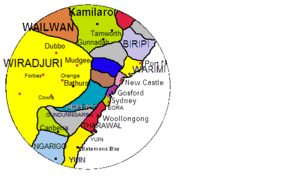Darkinjung language facts for kids
Quick facts for kids Darkinjung |
|
|---|---|
| Hawkesbury–MacDonald River | |
| Native to | Australia |
| Region | New South Wales |
| Ethnicity | Darkinjung, Darkinung |
| Era | attested 1903 |
| Language family |
Pama–Nyungan
|
| Dialects |
Darrkinyung
Hawkesbury River–Broken Bay?
|
| AIATSIS | S65 |

Traditional lands of Aboriginal Australian tribes around Sydney; Darkinjung in brown
|
|
Darkinjung (also called Darrkinyung) is an Aboriginal language from Australia. It was the traditional language of the Darkinjung people. These people lived in a part of southeastern Australia, in what is now the New South Wales area.
Sadly, no recordings of the Darkinjung language exist today. However, researchers have collected lists of words and descriptions of its grammar. This helps us learn about the language. Darkinjung is now considered a language that is no longer fully spoken. Because of this, there are efforts to bring it back to life through a special program.
The Darkinjung language was spoken next to other Aboriginal languages like Dharuk, Wiradhuri, Gamilaraay, and Awabakal.
Contents
Different Names for Darkinjung
The Darkinjung language has many different spellings. This is because early researchers, like Mathews and W.J. Enright, wrote down the sounds they heard in different ways. These spellings were recorded in the 1800s and early 1900s.
Here are some of the ways the name has been spelled:
- Darkinjang
- Darkinjung
- Darkiñung
- Darrkinyung
- Darginjang
- Darginyung
- Darkinung
- Darkinoong
- Darknüng
- Darkinyung
Bringing the Language Back to Life
Since 2003, the Darkinyung language group has been working hard to revitalise their language. This means they are trying to bring it back into use. They started by studying old reports from Robert H. Mathews and W. J. Enright. These reports contained some words and grammar rules.
When there were missing words, they looked at similar languages nearby. This helped them fill in the gaps. All this hard work led to a book called Darkinyung grammar and dictionary: revitalising a language from historical sources. This book is a big step in helping new generations learn Darkinjung. You can get this book from the Muurrbay Aboriginal Language and Culture Co-operative.
Sounds of Darkinjung
Most of what we know about the sounds in Darkinjung comes from papers written by R.H. Mathews in 1903. From these old writings, we can guess that the language had about 15 different consonant sounds and around 3 vowel sounds.
Consonant Sounds
In Darkinjung, some sounds like 'b', 'd', and 'g' could be swapped with 'p', 't', and 'k' without changing the meaning of a word. This is common in many Aboriginal languages.
Vowel Sounds
Darkinjung likely had three main vowel sounds, similar to the 'i' in "sit", the 'oo' in "book", and the 'a' in "about".
How Words Are Built
Darkinjung uses special endings, called "tags" or suffixes, added to words. These tags help show how words are related in a sentence.
Word Endings (Tags)
- Number Tags:
* The tag -bula means "two". * The tag -biyn means "several".
miri-bula
dog-two
'a couple of dogs'
- Possessor Tag:
* The tag -gayi shows that something belongs to someone.
guri-
man
gayi
POSS
bargan
boomerang
'a man's boomerang'
- Location Tags:
* Tags like -a, -da, -dja, -ga, and -wa mean "at", "on", or "in". * The tags -ga and -wa are usually used after words that end with a vowel sound.
gawin-da
bank-LOC
nhayi
that.over.there
'on the other side'
Words that describe a location often have one of these tags:
wallang-gayn-dja
behind-?-LOC
gundji-ga
hut-LOC
gara-dhi
hide-PRES
'around the house, hidden'
- Doer Tags (Ergative Case):
* Tags like -a, -da, -ga, and -ya show who is doing the action in a sentence. * Words ending in the 'ŋ' sound (like the 'ng' in "sing") usually get the -ga tag.
nyugang-ga
woman-ERG
wagar
perch
mana-yi
get-PAST
'the woman caught a perch'
See also
 In Spanish: Idioma darkinjung para niños
In Spanish: Idioma darkinjung para niños

